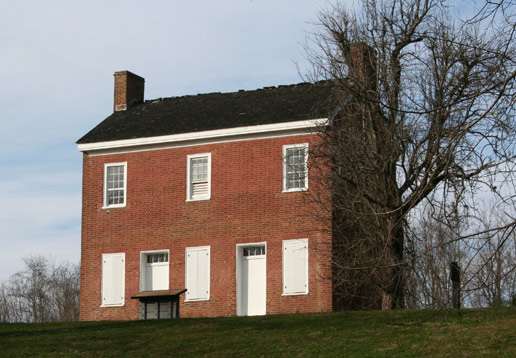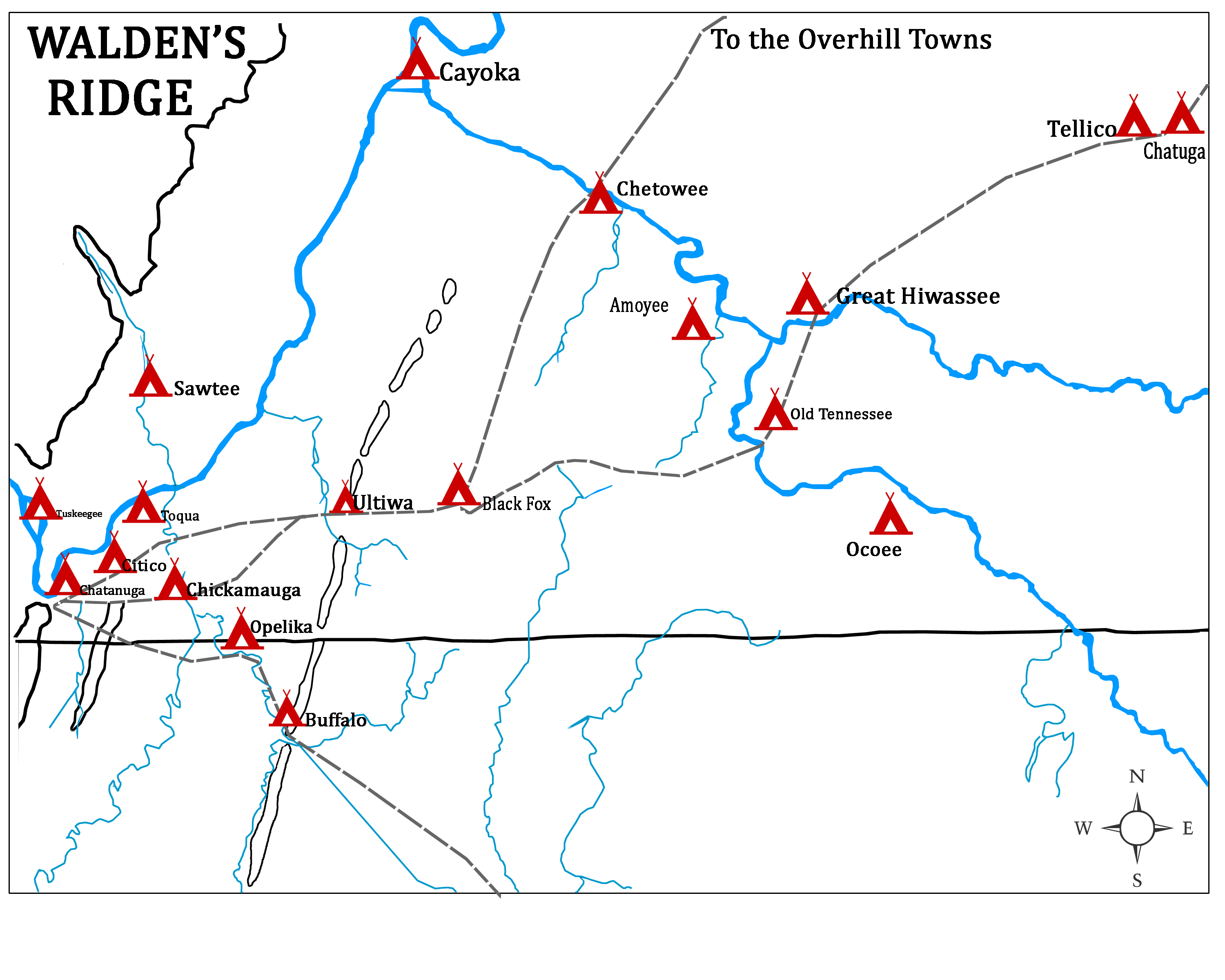|
John Gordon (militia Captain)
John Gordon, (July 15, 1759 – June 6, 1819) was an American pioneer, Indian trader, planter, and militia captain in several Indian wars. Part of the post-Revolutionary War settlement of the trans- Appalachian frontier, Gordon was an early settler in the Nashville, Tennessee area. He gained notability and rank in the Tennessee Militia, fighting against the Creeks and Seminoles for Andrew Jackson, during the War of 1812. Jackson referred to him as his "Captain of the Spies." Partnering with a Chickasaw chieftain, Gordon helped improve the Natchez Trace, which gave access to the settlers pushing into western Tennessee and south into the Louisiana and Mississippi territories. He was a key figure major battles of the Creek War, including the Battle of Horseshoe Bend, and the capture of Pensacola from the British. Early life and Tennessee settler Gordon was born in Spotsylvania County, Virginia to an aristocratic landholding family. His father had fought in the War of Indepen ... [...More Info...] [...Related Items...] OR: [Wikipedia] [Google] [Baidu] |
Spotsylvania County, Virginia
Spotsylvania County is a county in the U.S. state of Virginia. As of the July 2021 estimate, the population was 143,676. Its county seat is Spotsylvania Courthouse. History At the time of European encounter, the inhabitants of the area that became Spotsylvania County were a Siouan-speaking tribe called the Manahoac. As the colonial population increased, Spotsylvania County was established in 1721 from parts of Essex, King and Queen, and King William counties. The county was named in Latin for Lieutenant Governor of Virginia Alexander Spotswood who incidentally was also the second greatgrandfather of Robert E Lee. Many major battles were fought in this county during the Civil War, including the Battle of Chancellorsville, Battle of the Wilderness, Battle of Fredericksburg, and Battle of Spotsylvania Court House. The war resulted in widespread disruption and opportunity: some 10,000 African-American slaves left area plantations and city households to cross the Rappahannock Ri ... [...More Info...] [...Related Items...] OR: [Wikipedia] [Google] [Baidu] |
Natchez Trace
The Natchez Trace, also known as the Old Natchez Trace, is a historic forest trail within the United States which extends roughly from Nashville, Tennessee, to Natchez, Mississippi, linking the Cumberland, Tennessee, and Mississippi rivers. The trail was created and used by Native Americans for centuries, and was later used by early European and American explorers, traders, and emigrants in the late 18th and early 19th centuries. European Americans founded inns, also known as "stands", along the Trace to serve food and lodging to travelers. As travel shifted to steamboats on the Mississippi and other rivers, most of these stands closed. Today, the path is commemorated by the Natchez Trace Parkway, which follows the approximate path of the Trace, as well as the related Natchez Trace Trail. Parts of the original trail are still accessible, and some segments are listed on the National Register of Historic Places. Origins Largely following a geologic ridge line, prehist ... [...More Info...] [...Related Items...] OR: [Wikipedia] [Google] [Baidu] |
Pocahontas
Pocahontas (, ; born Amonute, known as Matoaka, 1596 – March 1617) was a Native American woman, belonging to the Powhatan people, notable for her association with the colonial settlement at Jamestown, Virginia. She was the daughter of Powhatan, the paramount chief of a network of tributary tribes in the Tsenacommacah, encompassing the Tidewater region of Virginia. Pocahontas was captured and held for ransom by English colonists during hostilities in 1613. During her captivity, she was encouraged to convert to Christianity and was baptized under the name Rebecca. She married tobacco planter John Rolfe in April 1614 at the age of about 17 or 18, and she bore their son Thomas Rolfe in January 1615. In 1616, the Rolfes travelled to London where Pocahontas was presented to English society as an example of the "civilized savage" in hopes of stimulating investment in the Jamestown settlement. On this trip she may have met Squanto, a "Patuxet Native American" from New Englan ... [...More Info...] [...Related Items...] OR: [Wikipedia] [Google] [Baidu] |
First Families Of Virginia
First Families of Virginia (FFV) were those families in Colonial Virginia who were socially prominent and wealthy, but not necessarily the earliest settlers. They descended from English colonists who primarily settled at Jamestown, Williamsburg, the Northern Neck and along the James River and other navigable waters in Virginia during the 17th century. These elite families generally married within their social class for many generations and, as a result, most surnames of First Families date to the colonial period. The American Revolution cut ties with Britain but not with its social traditions. While some First Family members were loyal to Britain, others were Whigs who not only supported, but led the Revolution. Most First Families remained in Virginia, where they flourished as tobacco planters, and from the sale of enslaved people to the cotton states to the south. Indeed, many younger sons were relocated into the cotton belt to start their own plantations. With the emancipati ... [...More Info...] [...Related Items...] OR: [Wikipedia] [Google] [Baidu] |
Felix Zollicoffer
Felix Kirk Zollicoffer (May 19, 1812 – January 19, 1862) was an American newspaperman, slave owner, politician, and soldier. A three-term United States Congressman from Tennessee, an officer in the United States Army, and a Confederate brigadier general during the American Civil War; he led the first Confederate invasion of eastern Kentucky and was killed in action at the Battle of Mill Springs. Zollicoffer was the first Confederate general to die in the Western Theater. Early life and career Felix Zollicoffer was born on a plantation in Bigbyville in Maury County, Tennessee,Eicher, John H., and David J. Eicher. ''Civil War High Commands''. Stanford, California: Stanford University Press, 2001. . p. 586. a son of John Jacob and Martha (Kirk) Zollicoffer.Adkins, Ray''Battle of Barboursville, Kentucky'' Morrisville, North Carolina: Lulu, 2008. . p. 17. He was descended from emigrants from Switzerland who had settled in North Carolina in 1710. His grandfather, George Zollicoff ... [...More Info...] [...Related Items...] OR: [Wikipedia] [Google] [Baidu] |
Confederate States
The Confederate States of America (CSA), commonly referred to as the Confederate States or the Confederacy was an unrecognized breakaway republic in the Southern United States that existed from February 8, 1861, to May 9, 1865. The Confederacy comprised U.S. states that declared secession and warred against the United States during the American Civil War: South Carolina, Mississippi, Florida, Alabama, Georgia, Louisiana, Texas, Virginia, Arkansas, Tennessee, and North Carolina. Kentucky and Missouri also declared secession and had full representation in the Confederate Congress, though their territory was largely controlled by Union forces. The Confederacy was formed on February 8, 1861, by seven slave states: South Carolina, Mississippi, Florida, Alabama, Georgia, Louisiana, and Texas. All seven were in the Deep South region of the United States, whose economy was heavily dependent upon agriculture—particularly cotton—and a plantation system that relied upon enslaved A ... [...More Info...] [...Related Items...] OR: [Wikipedia] [Google] [Baidu] |
Tennessee River Gorge
The Tennessee River Gorge is a canyon formed by the Tennessee River known locally as Cash Canyon. It is the fourth largest river gorge in the Eastern United States. The gorge is cut into the Cumberland Plateau as the river winds its way into Alabama from Tennessee. The Tennessee River Gorge was also known as Walden Gorge. Walden Ridge originally extended across the present path of the Tennessee River at the gorge to Sand Mountain. Ecology The Tennessee River Gorge is home to endangered species like the mountain skullcap. Many archaeological sites have been discovered in the gorge that show that people have been dwelling in the canyon for at least 10,000 years. History Prior to the completion of Hales Bar Dam in 1913 and the subsequent raising of the water-level, the stretch of the Tennessee River flowing through the Gorge was notorious for its navigational hazards, whirlpools, eddies, shoals, and one huge rock. Beginning with Williams' Island and the sandbars on either side of ... [...More Info...] [...Related Items...] OR: [Wikipedia] [Google] [Baidu] |
Chickamauga Cherokee
The Chickamauga Cherokee refers to a group that separated from the greater body of the Cherokee during the American Revolutionary War. The majority of the Cherokee people wished to make peace with the Americans near the end of 1776, following several military setbacks and American reprisals. The followers of the skiagusta (or red chief), Dragging Canoe, moved with him in the winter of 1776–77 down the Tennessee River away from their historic Overhill Cherokee towns. Relocated in a more isolated area, they established 11 new towns in order to gain distance from colonists' encroachments. The frontier Americans associated Dragging Canoe and his band with their new town on Chickamauga Creek and began to refer to them as the ''Chickamaugas.'' Five years later, the Chickamauga moved further west and southwest into present-day Alabama, establishing five larger settlements. They were then more commonly known as the ''Lower Cherokee''. This term was closely associated with the peop ... [...More Info...] [...Related Items...] OR: [Wikipedia] [Google] [Baidu] |
William Blount
William Blount (March 26, 1749March 21, 1800) was an American Founding Father, statesman, farmer and land speculator who signed the United States Constitution. He was a member of the North Carolina delegation at the Constitutional Convention of 1787 and led the efforts for North Carolina to ratify the Constitution in 1789 at the Fayetteville Convention. He then served as the only governor of the Southwest Territory and played a leading role in helping the territory gain admission to the union as the state of Tennessee. He was selected as one of Tennessee's initial United States Senators in 1796, serving until he was expelled for treason in 1797.Terry Weeks,William Blount" ''Tennessee Encyclopedia of History and Culture'', 2010. Accessed 10 September 2012. Born to a prominent North Carolina family, Blount served as a paymaster during the American Revolutionary War. He was elected to the North Carolina legislature in 1781, where he remained in one role or another for most of the d ... [...More Info...] [...Related Items...] OR: [Wikipedia] [Google] [Baidu] |
Southwest Territory
The Territory South of the River Ohio, more commonly known as the Southwest Territory, was an organized incorporated territory of the United States that existed from May 26, 1790, until June 1, 1796, when it was admitted to the United States as the State of Tennessee. The Southwest Territory was created by the Southwest Ordinance from lands of the Washington District that had been ceded to the U.S. federal government by North Carolina. The territory's lone governor was William Blount. The establishment of the Southwest Territory followed a series of efforts by North Carolina's trans-Appalachian residents to form a separate political entity, initially with the Watauga Association, and later with the failed State of Franklin. North Carolina ceded these lands in April 1790 as payment of obligations owed to the federal government. The territory's residents welcomed the cession, believing the federal government would provide better protection from Indian hostilities. The federal go ... [...More Info...] [...Related Items...] OR: [Wikipedia] [Google] [Baidu] |
American Revolutionary War
The American Revolutionary War (April 19, 1775 – September 3, 1783), also known as the Revolutionary War or American War of Independence, was a major war of the American Revolution. Widely considered as the war that secured the independence of the United States, fighting began on April 19, 1775, followed by the Lee Resolution on July 2, 1776, and the Declaration of Independence on July 4, 1776. The American Patriots were supported by the Kingdom of France and, to a lesser extent, the Dutch Republic and the Spanish Empire, in a conflict taking place in North America, the Caribbean, and the Atlantic Ocean. Established by royal charter in the 17th and 18th centuries, the American colonies were largely autonomous in domestic affairs and commercially prosperous, trading with Britain and its Caribbean colonies, as well as other European powers via their Caribbean entrepôts. After British victory over the French in the Seven Years' War in 1763, tensions between the motherland and he ... [...More Info...] [...Related Items...] OR: [Wikipedia] [Google] [Baidu] |
John Gordon House
The John Gordon House is a historic brick home located along the Old Natchez Trace near Williamsport, Tennessee, within the boundaries of the Natchez Trace Parkway, a National Park Service unit. History The house was built in 1818. It is one of only two remaining structures from the early history of the Natchez Trace located along the Natchez Trace Parkway. It was built by John Gordon and his wife Dolly, the main house of a plantation that included 1500 acres, a ferry over the Duck River and a trading post. The land was originally located in Chickasaw territory when Gordon acquired it. The National Park Service acquired the Gordon House and surrounding property in 1973. In 1974, the home was listed on the National Register of Historic Places The National Register of Historic Places (NRHP) is the United States federal government's official list of districts, sites, buildings, structures and objects deemed worthy of preservation for their historical significance or "great a ... [...More Info...] [...Related Items...] OR: [Wikipedia] [Google] [Baidu] |








